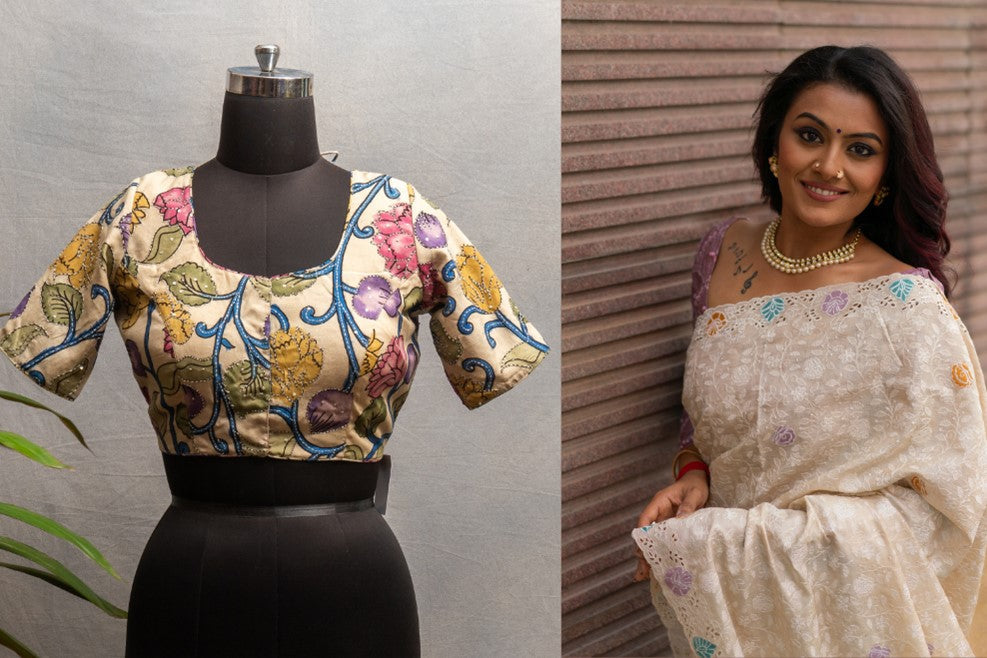Introduction:
Traditional Kanchipuram silk saree motifs are inspired by nature, ancient temples, and sculptures of Tamil Nadu. They play a significant role in showcasing the rich culture and heritage of India. More than just attire, handloom Kanchipuram silk sarees have the authenticity to be considered art.
In this blog, let’s take a close look at significant motifs of Kanchipuram silk sarees which are mainly used in the body of kanjivaram silk sarees since time immemorial.
Vaira Oosi – The Diamond Needle Stripes
Presenting here a popular yet traditional Kanchipuram silk saree design – Vaira Oosi. In Tamil, this design Vaira Oosi is also called the diamond needle pattern. This weaving technique involves one thread line and one zari line or two thread lines in the warp interspaced with one zari line. Vaira Oosi Kanchipuram silk sarees shimmer like diamonds, which is why they are named Vaira Oosi. Every south Indian bride’s favourite Kanchi silk saree is one vairaoosi Kanchi silk saree. This green Vaira Oosi Kanjivaram silk saree is woven with closely parallel zari and thread lines using traditional weaving methods. It comes with a zari-rich pallu, giving it a luxurious and elegant look.
This green Vaira Oosi Kanjivaram silk saree is woven with closely parallel zari and thread lines using traditional weaving methods. It comes with a zari-rich pallu, giving it a luxurious and elegant look.
Oosi Kattam – The Delicate Checkered Pattern
Oosi Kattam is one of the traditional designs of Kanchipuram silk sarees, loved by women of all ages. Oosi Kattam means a fine checkered pattern, a handwoven design that enhances the overall look of the saree. It is a traditional weaving technique that requires precision to create a delicate appearance. This yellow Oosi Kattam Kanchipuram silk saree is adorned with beautiful intricate work. The saree is complemented by a contrast pallu and border woven in korvai weaving technique a special technique used in Kanchi silk sarees to weave contrast borders. Tiny zari work along with the Oosi Kattam pattern brings a vintage look to this saree.
This yellow Oosi Kattam Kanchipuram silk saree is adorned with beautiful intricate work. The saree is complemented by a contrast pallu and border woven in korvai weaving technique a special technique used in Kanchi silk sarees to weave contrast borders. Tiny zari work along with the Oosi Kattam pattern brings a vintage look to this saree.
Veldhari – The Creeper Design
The Veldhari motif is inspired by the vine patterns of nature and transforms into art in sarees. Many of us must have spotted the Veldari design in temple carvings, and who wouldn’t love to drape it as a saree? The Veldhari silk sarees motif symbolizes continuity and growth, just like a vine grows. If you are someone who loves traditional designs on sarees and cherishes them, then this Veldhari-designed woven Kanchipuram silk saree is made for you. In this saree, the Veldhari motif is handwoven all over the body and complemented with a beautiful contrast orange Korvai border. To add to this beauty, this blue veldhari silk saree features the Adai weaving technique, one of the oldest weaving techniques in Kanchipuram.
If you are someone who loves traditional designs on sarees and cherishes them, then this Veldhari-designed woven Kanchipuram silk saree is made for you. In this saree, the Veldhari motif is handwoven all over the body and complemented with a beautiful contrast orange Korvai border. To add to this beauty, this blue veldhari silk saree features the Adai weaving technique, one of the oldest weaving techniques in Kanchipuram.
Thodarkodi – A Never-Ending Pattern
Thodarkodi is a unique pattern that has been woven into Kanchipuram silk sarees for generations. Thodarkodi – the name means continuity, which also symbolizes growth and prosperity. The intertwined creepers woven into the saree make it a truly unique piece. In this magenta saree, Thodarkodi designs are perfectly handwoven throughout the body, giving it an elegant and contemporary look.
In this magenta saree, Thodarkodi designs are perfectly handwoven throughout the body, giving it an elegant and contemporary look.
Conclusion
Kanchipuram silk sarees add beauty to the rich culture of India. Every motif and pattern holds a beautiful story or meaning behind it. This makes traditional Kanchi silk sarees always sought after as they carry all their cultural significance into the modern, evolving world.



